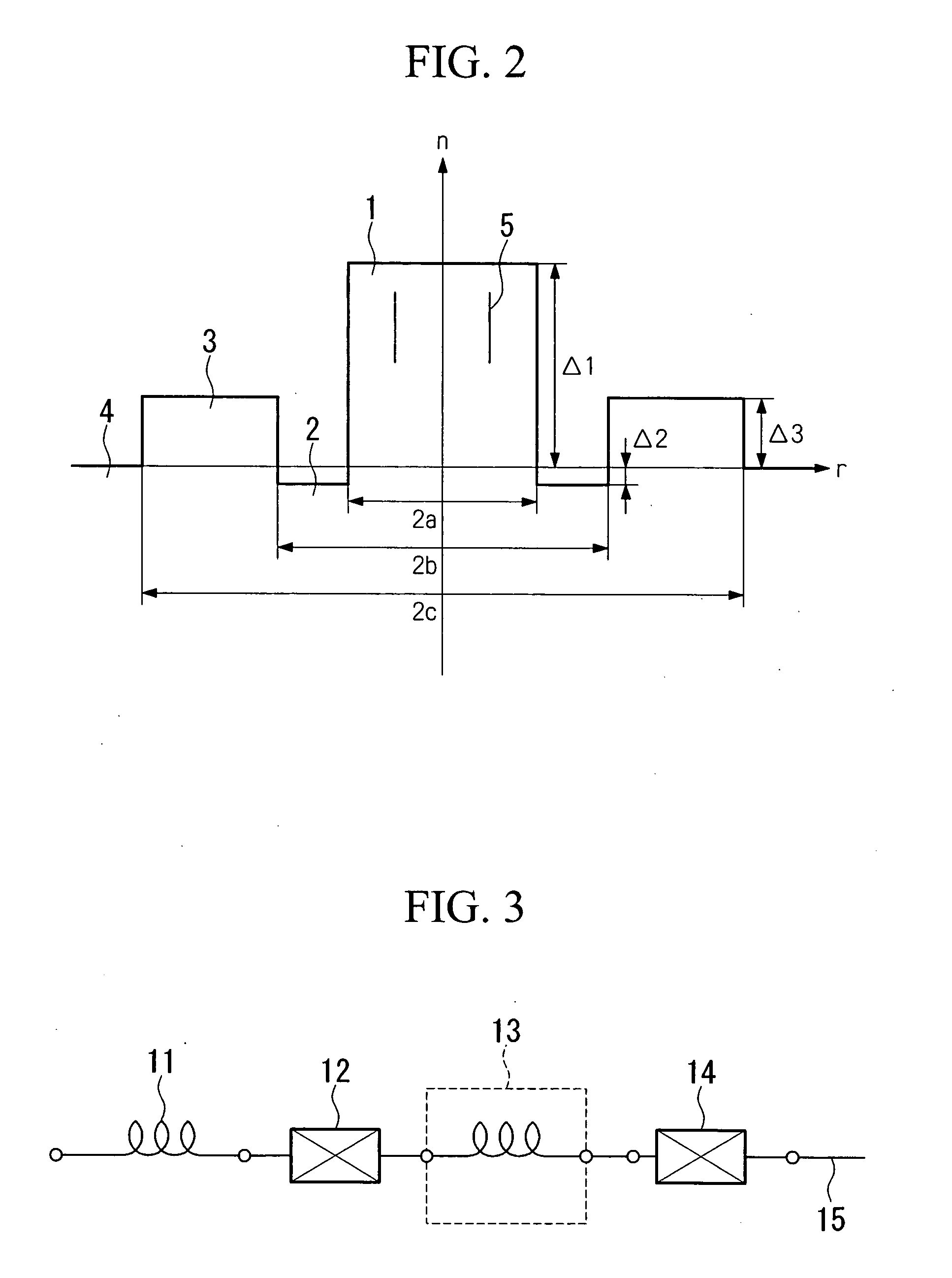Higher order mode dispersion compensating fiber and mode converter for higher order fiber
a higher-order fiber and mode converter technology, applied in the direction of optical fibers with multi-layer cores/claddings, optical waveguide light guides, instruments, etc., can solve the problems of difficult manufacture of lpg converters, difficult lowering multi-pass interference, and inability to eliminate the interference between lower and higher-order modes propagating therethrough. , to achieve the effect of reducing the wavelength dependence of propagation loss
- Summary
- Abstract
- Description
- Claims
- Application Information
AI Technical Summary
Benefits of technology
Problems solved by technology
Method used
Image
Examples
example 1
[0120] A higher order mode dispersion compensating fiber having the structural parameters shown in Example 1 of Table 1 was fabricated by modified chemical vapor deposition. This dispersion compensating fiber could propagate the LP01, the LP02, and the LP03 modes. The electric field distribution in the LP01 mode is shown in FIG. 4, the electric field distribution in the LP02 mode in FIG. 5, and the electric field distribution in the LP03 mode is in FIG. 6.
[0121] The dispersion characteristics in the LP02 mode is shown in FIG. 7. As can be seen in FIG. 7, the dispersion at a wavelength of 1.55 μm is approximately −1100 ps / nm / km.
TABLE 1Example 1Example 22a(μm)8.368.402b(μm)14.6014.502c(μm)27.0026.00Δ10.02270.0181Δ2−0.00200.0000Δ30.00770.0039
[0122] In FIG. 5 showing the electric field distribution of the LP02 mode, a loss layer was provided at the position where the electric field becomes zero in the electric field distribution profile, at a radial distance of 2.20 μm from the cente...
example 2
[0128] A higher order mode dispersion compensating fiber having the structural parameters shown in Example 2 of Table 1 was fabricated by modified chemical vapor deposition. This dispersion compensating fiber could propagate the LP01, the LP02, and the LP03 modes. The electric field distribution in the LP01 mode is shown in FIG. 9, the electric field distribution in the LP02 mode in FIG. 10, and the electric field distribution in the LP03 mode is in FIG. 11.
[0129] The dispersion characteristic in the LP02 mode is shown in FIG. 12. As can be seen in FIG. 12, the dispersion at a wavelength of 1.55 μm is approximately −440 ps / nm / km.
[0130] In FIG. 10 showing the electric field distribution of the LP02 mode, a loss layer was provided at the position where the electric field becomes zero in the electric field distribution profile, at a radial distance of 2.30 μm from the center. The loss layer was formed by doping 7.6 mole % of boron trioxide into germanium-doped silica of which the cen...
example 3
[0186] A higher order mode dispersion compensating fiber having the structural parameters shown in Example 3 of Table 4 was fabricated by modified chemical vapor deposition. This dispersion compensating fiber could propagate the LP01, the LP02, and the LP03 modes. The dispersion characteristics in the LP02 mode are shown in FIG. 17. As can be seen in FIG. 17, the dispersion at a wavelength of 1.55 μm is approximately −1200 ps / nm / km.
TABLE 4Example 3Example 42a(μm)8.368.402b(μm)14.6014.502c(μm)27.0026.00Δ10.02270.0181Δ2−0.00200.0000Δ30.00770.0039
[0187] In this dispersion compensating fiber, first and second loss layers were provided by the following procedure. The first loss layer was formed at a radial distance of 2.20 μm from the center by doping 16.8 mole % of boron trioxide (B2O3) into germanium-doped silica of which the central core region is made with a thickness of 0.2 μm and A1 of 155 dB.
[0188] The second loss layer was formed at a radial distance of 8.49 μm from the center...
PUM
 Login to View More
Login to View More Abstract
Description
Claims
Application Information
 Login to View More
Login to View More - R&D
- Intellectual Property
- Life Sciences
- Materials
- Tech Scout
- Unparalleled Data Quality
- Higher Quality Content
- 60% Fewer Hallucinations
Browse by: Latest US Patents, China's latest patents, Technical Efficacy Thesaurus, Application Domain, Technology Topic, Popular Technical Reports.
© 2025 PatSnap. All rights reserved.Legal|Privacy policy|Modern Slavery Act Transparency Statement|Sitemap|About US| Contact US: help@patsnap.com



